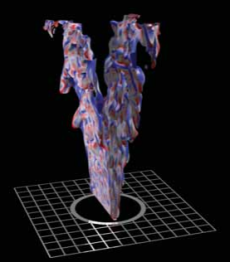Groundbreaking Combustion Research by CRD Featured on Cover of Proceedings of National Academy of Sciences
July 1, 2005

CCSE staff produced this 3D laboratory-scale turbulent flame simulation which closely matched a combustion experiment.
Computational and combustion scientists at Berkeley Lab have earned national recognition in the July 19, 2005 Proceedings of the National Academy of Sciences with their cover article about unparalleled computer simulations of turbulent flames.
The research by scientists in CRD’s Center for Computational Sciences and Engineering and in the Environmental Energy Technologies Division has led to a three-dimensional combustion simulation of unmatched size without resorting to models for turbulence or turbulence- chemistry interactions. The article shows that the simulation closely matches a combustion experiment.
Gaining a better understanding of combustion, which powers everything from automobiles to aircraft to power generating plants, can help improve the efficiency of those system as well as help reduce the amount of pollution produced by burning fossil fuels.
“Although collaborations between computa- tional scientists and experimentalists are becoming increasingly common, the results from this project clearly demonstrate how scientific computing is coming into its own as an essential component of scientific discovery,” said Horst Simon, Associate Laboratory Director for Computing Sciences at Berkeley Lab. “The simulation is unprecedented in several aspects — the number of chemical species included, the number of chemical processes modeled, and the overall size of the flame. This is truly breakthrough computational science.”
The article, written by John B. Bell, Marc S. Day, Ian G. Shepherd, Matthew R. Johnson, Robert K. Cheng, Joseph F. Grcar, Vincent E. Beckner and Michael J. Lijewski, describes the simulation of “a laboratory- scale turbulent rod-stabilized premixed methane V-flame. This simulation, which models a full laboratory-scale flame by using detailed chemistry and transport, encompasses a domain more than three orders of magnitude larger in volume than that of any previous efforts and represents a major increment in simulation complexity.”
The LBNL combustion simulations use a different mathematical approach than has been typically used. Most other combustion simulations without turbulence models use equations that include sound waves, making them very computationally expensive. Because of this, such simulations often have been limited to only two dimensions, to scales less than a centimeter, or to just a few carbon species and reactions. By contrast, the LBNL researchers have modeled a three-dimensional flame about 12 cm high and consisting of 19 chemical species and 84 fundamental chemical reactions, producing results that could be compared directly with experimental diagnostics.
The LBNL group has developed an algorithmic approach that combines the “low Machnumber equations,” which remove sound waves, with “adaptive mesh refinement” (AMR). The combined methodology strips away relatively unimportant aspects of the simulation and focus computing resources on the most important processes. Developed with the support of the Applied Mathematics Program of the DOE Office of Advanced Scientific Computing Research, the group’s algorithms have slashed compu- tational costs for combustion simulations by a factor of 10,000. Even so, the combustion simulation required substantial computing power — the simulation ran for about 1,000 hours on 256 processors of the IBM SP supercomputer at DOE’s National Energy Research Scientific Computing Center.
The collaboration between computational and combustion scientists described in the National Academy Proceedings was supported by the Applied Partial Differential Equations Center (APDEC) of DOE’s Scientific Discovery through Advanced Computation (SciDAC) program. The combustion experiments were supported by DOE’s Office of Basic Energy Sciences in the Office of Science. The work also received support from Cristina Siegerist and Wes Bethel of LBNL’s Visualization Group.
Researchers and institutions with a subscrip- tion to the Proceedings of the National Academy of Sciences can access the paper at <http://www.pnas.org/cgi/content/short/ 102/29/10006>.
About Computing Sciences at Berkeley Lab
High performance computing plays a critical role in scientific discovery. Researchers increasingly rely on advances in computer science, mathematics, computational science, data science, and large-scale computing and networking to increase our understanding of ourselves, our planet, and our universe. Berkeley Lab’s Computing Sciences Area researches, develops, and deploys new foundations, tools, and technologies to meet these needs and to advance research across a broad range of scientific disciplines.







 Instagram
Instagram YouTube
YouTube